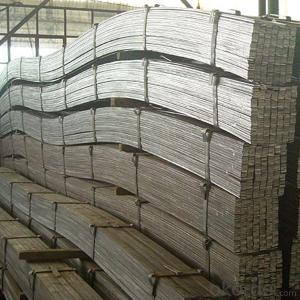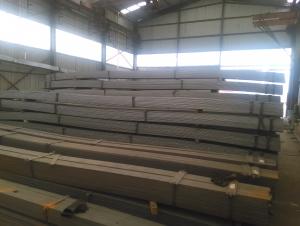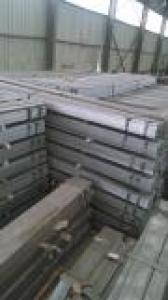8.79KG/M steel flat bar for construction
- Loading Port:
- Tianjin
- Payment Terms:
- TT OR LC
- Min Order Qty:
- 10000 m.t.
- Supply Capability:
- 100000 m.t./month
OKorder Service Pledge
OKorder Financial Service
You Might Also Like
Product Description:
OKorder is offering 8.79KG/M steel flat bar for construction at great prices with worldwide shipping. Our supplier is a world-class manufacturer of steel, with our products utilized the world over. OKorder annually supplies products to European, North American and Asian markets. We provide quotations within 24 hours of receiving an inquiry and guarantee competitive prices.
Product Applications:
8.79KG/M steel flat bar are ideal for structural applications and are widely used in the construction of buildings and bridges, and the manufacturing, petrochemical, and transportation industries.
Product Advantages:
OKorder's Steel Flat Bar for construction are durable, strong, and resist corrosion.
Main Product Features:
· Premium quality
· Prompt delivery & seaworthy packing (30 days after receiving deposit)
· Corrosion resistance
· Can be recycled and reused
· Mill test certification
· Professional Service
· Competitive pricing
Product Specifications:
Manufacture: slited
Slitting precision (width) : 0.5 mm or less
Raw material: Q235B, Q345B, Q235-1 b
crosscutting precision (length) : 2 mm or less
Processing: the thickness of 2.0-16 mm;
Shear length: 2000 mm above
Wide degree: 15-1250 - mm;
Leveling precision: 1-2 MM square
Packaging: Export packing, nude packing, bundled
The Carbon Steel Flat Bar is made through three processes:
1.Feeding the material: Feeding the row material (the steel plate) to Slitting Line.
2.Slitting:The steel plate would be slitted into expected width by lengthways cutter.
3. Leveled and cutting: The plat bar would be ground into level by the grinder and then cut into required length.
FAQ:
Q1: How soon can we receive the product after purchase?
A1: Within three days of placing an order, we will begin production. The specific shipping date is dependent upon international and government factors, but is typically 7 to 10 workdays.
Q2: What makes stainless steel stainless?
A2: Stainless steel must contain at least 10.5 % chromium. It is this element that reacts with the oxygen in the air to form a complex chrome-oxide surface layer that is invisible but strong enough to prevent further oxygen from "staining" (rusting) the surface. Higher levels of chromium and the addition of other alloying elements such as nickel and molybdenum enhance this surface layer and improve the corrosion resistance of the stainless material.
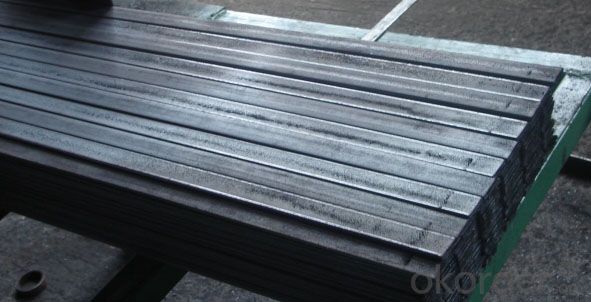
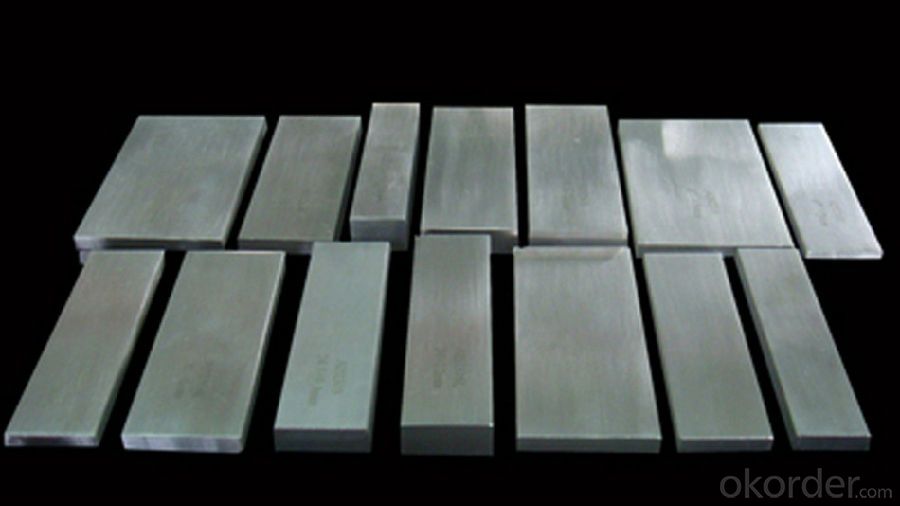
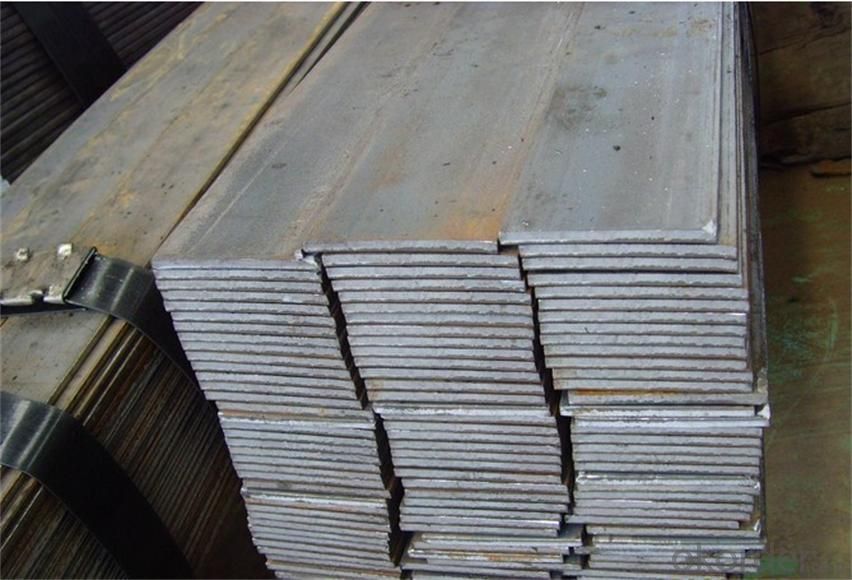
- Q:Can steel flat bars be used for making gardening tools?
- Yes, steel flat bars can be used for making gardening tools. Steel is a durable and strong material that is commonly used for constructing various types of tools, including gardening tools. Flat bars can be shaped and formed into different gardening tool designs, such as shovels, rakes, hoes, and garden forks, providing the necessary strength and functionality for these tools to be effective in gardening tasks.
- Q:How do steel flat bars contribute to the overall durability of commercial structures?
- Steel flat bars contribute to the overall durability of commercial structures in several ways. Firstly, steel is known for its high strength and durability, making it an ideal material for construction. Steel flat bars have a high tensile strength, meaning they can withstand heavy loads and resist bending or warping under pressure. This strength allows commercial structures to support the weight of various elements, such as floors, walls, and roofs, ensuring their stability over time. Additionally, steel flat bars are resistant to corrosion, which is crucial in commercial structures where exposure to moisture and harsh weather conditions is common. Unlike other materials like wood or concrete, steel does not rot or deteriorate when exposed to water or moisture. This corrosion resistance helps prevent structural damage, ensuring the longevity and safety of the commercial building. Moreover, steel flat bars are highly versatile and can be customized to fit specific design requirements. They can be easily cut, drilled, and welded, allowing for flexibility in creating complex and intricate structures. This adaptability in design ensures that commercial structures can be constructed efficiently and with precision, resulting in a more durable and reliable building. Another important aspect is the fire resistance of steel flat bars. Steel is inherently non-combustible, meaning it does not contribute to the spread or intensity of fires. This fire-resistant quality makes steel flat bars a preferred material for commercial structures, as it enhances the safety of occupants and minimizes the potential for structural damage in the event of a fire. Lastly, steel flat bars are often used in reinforcement applications. They can be embedded within concrete structures, such as beams or columns, to enhance their load-bearing capacity. This reinforcement adds an extra layer of strength and durability to the commercial building, ensuring its ability to withstand heavy loads and potential impacts. In summary, steel flat bars contribute to the overall durability of commercial structures through their high strength, corrosion resistance, versatility in design, fire resistance, and reinforcement capabilities. Their incorporation in construction ensures the longevity, safety, and stability of commercial buildings, making them an essential component in the construction industry.
- Q:What is the maximum weight capacity of a steel flat bar?
- The maximum weight capacity of a steel flat bar depends on various factors such as its dimensions, grade of steel, and the intended use. Steel flat bars are typically available in different sizes and thicknesses, ranging from 1/8 inch to several inches thick. The weight capacity of a steel flat bar is determined by its strength and load-bearing capacity, which are determined by the grade of steel used. Higher grade steel with higher tensile strength can generally support greater weight loads. To determine the maximum weight capacity of a specific steel flat bar, it is essential to refer to engineering specifications or consult with a structural engineer. They can consider the dimensions, steel grade, and any additional factors such as support structures, intended load distribution, and safety factors required for the specific application. By analyzing these factors, they can provide an accurate maximum weight capacity for the steel flat bar in question.
- Q:Friction coefficient of steel pipe and flat steel on roller table!
- Flat, refers to the width 12-300mm, thickness 4-60mm, cross section is rectangular in shape and with a blunt edge of steel. Flat steel can be finished steel, or can be used as the blank of welded pipe and thin slab for laminated sheet rolling. Main application: flat steel is used as a material, used for making iron, tools and machinery parts, and used as frame structures and escalators for buildings.
- Q:Are steel flat bars available in standard lengths or custom lengths?
- Steel flat bars are available in both standard lengths and custom lengths. Standard lengths typically range from 6 to 12 feet, depending on the supplier and the specific dimensions of the flat bar. These standard lengths are commonly used in construction, manufacturing, and other industries. However, if you require a flat bar with a specific length that is not available in the standard range, most suppliers offer custom cutting services. This allows you to order steel flat bars in the exact length you need for your specific project or application. Custom lengths can be beneficial when working on unique projects or when you need to minimize waste and optimize material usage.
- Q:Are steel flat bars magnetic?
- Yes, steel flat bars are typically magnetic as they are made from ferrous metals such as carbon steel or stainless steel, which are magnetic in nature.
- Q:Are steel flat bars suitable for food processing or hygiene-sensitive environments?
- No, steel flat bars are not suitable for food processing or hygiene-sensitive environments due to their potential to corrode and contaminate the food or surface they come into contact with.
- Q:How long do steel flat bars typically last?
- Due to their durability and resistance to corrosion, steel flat bars are known to have a long lifespan. However, the length of time they last is contingent upon the conditions they are exposed to and the level of maintenance they receive. When properly cared for and shielded from moisture and harsh elements, steel flat bars can endure for many decades, or even longer. Conversely, if they are exposed to corrosive environments or neglected in terms of upkeep, their lifespan may be significantly diminished. Furthermore, the quality of the steel, the specific alloy used, and the amount of load or stress the flat bars experience can also impact their longevity. Therefore, it is crucial to conduct regular inspections and maintenance on steel flat bars to ensure they reach their optimal lifespan and performance.
- Q:Can steel flat bars be coated with corrosion-resistant materials?
- Coating steel flat bars with corrosion-resistant materials is possible. Various methods exist for applying these coatings, including hot-dip galvanizing, electroplating, powder coating, and painting. Hot-dip galvanizing entails immersing the steel flat bars in molten zinc, which creates a strong bond between the zinc and the steel. This coating provides excellent protection against corrosion and can withstand harsh environmental conditions. Electroplating is another technique that involves depositing a thin layer of corrosion-resistant metal, such as chromium or nickel, onto the steel flat bars through an electrochemical process. This process enhances the durability and corrosion resistance of the steel surface. Powder coating is an electrostatic application of dry powder coating onto the steel flat bars, followed by heat curing to form a protective layer. This coating not only provides corrosion resistance but also offers an attractive finish and can be applied in various colors. Lastly, painting is a commonly used method where a corrosion-resistant paint is applied to the steel flat bars. The paint acts as a barrier against moisture and other corrosive elements, preventing direct contact with the steel surface. In conclusion, there are several effective techniques for coating steel flat bars with corrosion-resistant materials, including hot-dip galvanizing, electroplating, powder coating, and painting. The choice of method depends on specific requirements, budget, and aesthetic preferences.
- Q:How are steel flat bars made?
- Hot rolling is the technique used to produce steel flat bars. The process starts by heating a large rectangular steel billet to extremely high temperatures. Subsequently, the heated billet is passed through a series of rollers that gradually shape and flatten it into a desired rectangular cross-section with a flat top and bottom surface. During hot rolling, the billet is compressed between the rollers, exerting immense pressure and force on the steel. This pressure causes the steel to elongate and reduce its thickness, while the width remains constant. With each set of rollers, the billet is gradually shaped into the desired flat bar profile. To ensure uniformity and precision, the steel bar may undergo multiple passes through the rolling mill. The rollers are adjusted accordingly to achieve the desired thickness and dimensions. Additionally, intermittent cooling may be applied between passes to control the steel's temperature and enhance its mechanical properties. Once the desired dimensions are attained, the steel flat bar is cut to the required length. If necessary, it may undergo further processing like straightening or surface finishing. After all the necessary steps, the steel flat bar is ready for various applications, including construction, manufacturing, and fabrication. In summary, the hot rolling process plays a crucial role in the efficient and cost-effective production of steel flat bars. These versatile and widely used metal products are made possible through this process.
1. Manufacturer Overview |
|
|---|---|
| Location | |
| Year Established | |
| Annual Output Value | |
| Main Markets | |
| Company Certifications | |
2. Manufacturer Certificates |
|
|---|---|
| a) Certification Name | |
| Range | |
| Reference | |
| Validity Period | |
3. Manufacturer Capability |
|
|---|---|
| a)Trade Capacity | |
| Nearest Port | |
| Export Percentage | |
| No.of Employees in Trade Department | |
| Language Spoken: | |
| b)Factory Information | |
| Factory Size: | |
| No. of Production Lines | |
| Contract Manufacturing | |
| Product Price Range | |
Send your message to us
8.79KG/M steel flat bar for construction
- Loading Port:
- Tianjin
- Payment Terms:
- TT OR LC
- Min Order Qty:
- 10000 m.t.
- Supply Capability:
- 100000 m.t./month
OKorder Service Pledge
OKorder Financial Service
Similar products
New products
Hot products
Hot Searches
Related keywords
